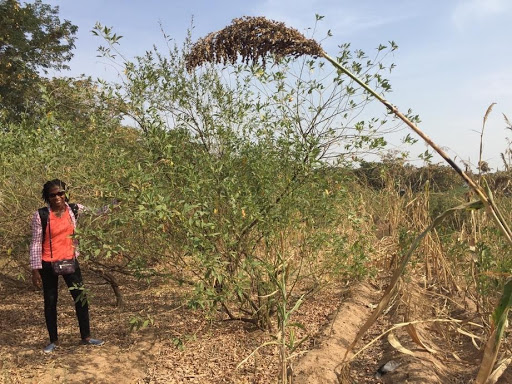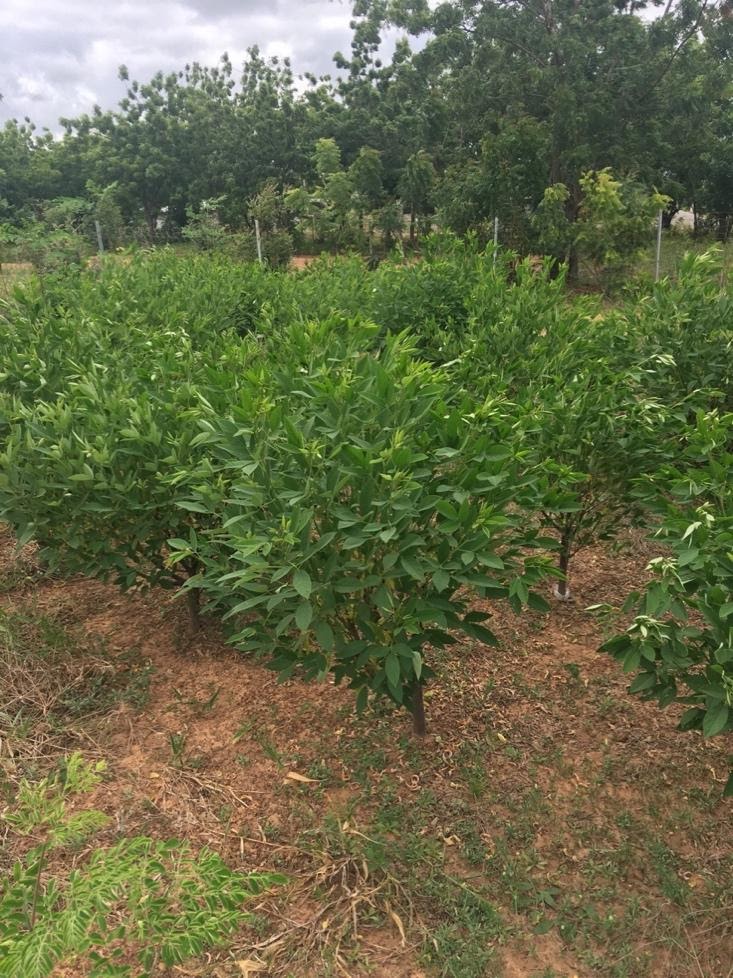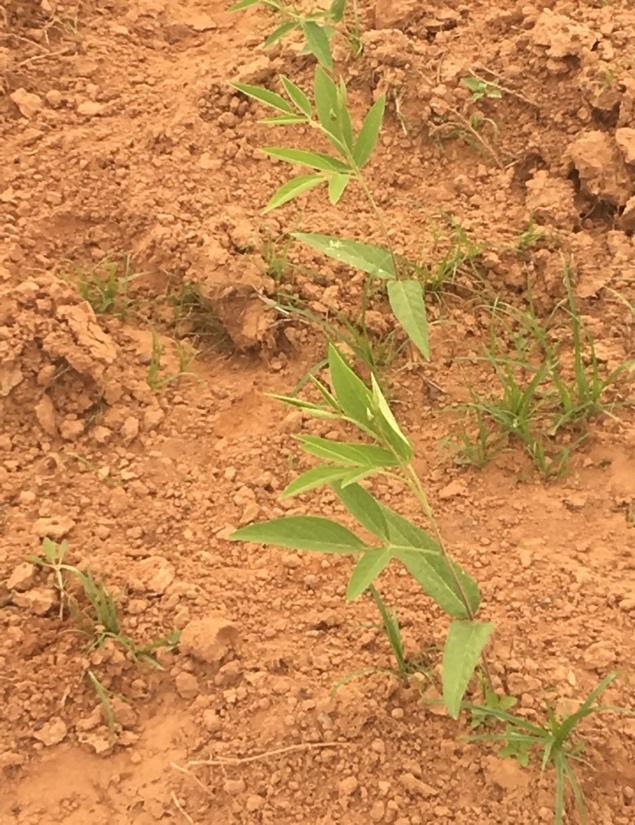FINAL PROJECT REPORT: Systems Research to Identify Legume Options for Sustainable Intensification: Pigeonpea and Mung Bean as Test Cases for Scaling in West Africa
Project Title: Systems research to identify legume options for sustainable intensification: Pigeonpea and mung bean as test cases for scaling in West Africa
Principal Investigators/Institutions: PI Dr. Sieglinde Snapp, Soil and Cropping Systems Ecologist; Co-PIs Dr. Joe Messina, Geographer, Michigan State University; Dr. Princess Hayford, Consultant
Executive Summary
Our goal was to implement a systems research approach to scaling out technologies, through a test case of the suitability niche for pigeonpea and mungbean. These two crops are not yet grown on any significant scale in West Africa, yet both fill unique cropping system functions. Pigeonpea as a long-duration, multipurpose crop; in addition to food, this crop provides vegetation for fodder and has unique ability in association with the root biome to enhance soil nitrogen and phosphorus availability. Mung bean as an early duration crop can be grown in relay and intercrop systems for a ‘hungry season’ food source and novel income generation.
Through crop model simulation and geospatial analysis, we investigated and mapped the biophysical and socioeconomic niche for introduction of pigeonpea as a novel species in West Africa. In addition, we explored the geospatial niche potential for mung bean. The maps generated showed the high potential sites for integration where pigeonpea and mung bean are predicted to grow well in Mali, Burkina Faso, Ghana and Nigeria. Further, we investigated through crop and soil simulation the potential impact of pigeonpea in Ghana in terms of production, environmental impacts on soil water relations and related benefits. Improved varieties of pigeonpea require adaptation to Ghana environmental conditions, as crop yield levels were markedly low. At the same time, local varieties and crop modeling based on medium and long-duration pigeonpea genotypes show outstanding potential to diversify and enhance environmental and food security benefits associated with sorghum systems. This was tested in Mali and Ghana, and simulation results indicated the potential for pigeonpea in combination with fertilizers to support enhanced soil fertility, fodder and potential for production of more stable sorghum yields. These findings were submitted to a premier agricultural development journal, International J. of Sust. Ag. In addition, maps were produced, shared with Ghanaian scientists, and made available through the Legume Systems Innovation lab and the Global Change website (http://globalchangescience.org/eastafricanode/) regarding geo-visualizations of the suitability niche for growing pigeonpea and for mungbean.
Utilization of the outputs of this grant include uptake by scientists in Ghana of the maps and crop modeling predictions, to design trials on pigeonpea and elephant grass. The plan is to investigate cropping system’s resilience and ability to improve the environment comparing forage from a legume and a grass, building on suitability of growth shown in our studies and maps. This is work based at the Tropical Agriculture, Tamale and Forest and Horticultural Crops Research Centre, Kade in Ghana.
Project Partners:
Dr. Fred Kizito, Chief Scientist with AFRICA RISING and Tropical Agriculture, Tamale and Forest and Horticultural Crops Research Centre, Kade in Ghana
Dr. Eric Owusudan, Crops Research Institute, Kumasi, Ghana
Project Goals and Objectives:
- Conduct a literature review, evaluate the global spatially-disaggregated crop production statistics data sets of IFPRI, and collect ground truth data on pigeonpea varieties growth and yield performance in sub-humid farming systems of Ghana.
- Design, test and geovisualize maps of pigeonpea and mungbean suitability grown niche across West Africa.
- Evaluate suitability for pigeonpea growth and integration into cropping systems in Ghana, including an assessment of water efficiency, environmental benefits and performance based on experimentation and APSIM crop and soil simulation modeling.
Overview of Activities:
- A literature review was conducted to assess crop coefficients and farming systems research on integration of pigeonpea and mung bean into cereal based, rain-fed cropping in West Africa. The literature review is included in the paper that was submitted to the Intl Journal of Sust Ag, led by Dr. Hayford.
- Dr. Princess Hayford traveled to five research stations and university locations acdross Ghana to meet with the key scientists involved in testing out pigeonpea genotypes for potential forage, grain, fuelwood or multiple use purposes. Dr. Hayford collected data, and presented to Ghanaian scientists the initial suitability maps for pigeonpea and mungbean prepared using the Google Earth Engine application we developed (Peter et al., 2020). The scientists expressed interest in the maps, and in exploring future collaboration opportunities. Several participated in writing a proposal, which was highly ranked but ultimately not funded, led by Dr. Snapp ‘Legume options for resilience in West Africa: Small, tall or both?’.
- Crop modeling was conducted, using APSIM calibrated with field experimentation data collected through activity above, this was conducted and pigeonpea growth over three decades of weather simulations was evaluated. Intercrop systems were not found to cause risk of crop failure under drought conditions, with one exception based on high fertility where the crops outgrew the soil moisture available.
- Finalized maps were prepared, for the suitability niche associated with growing long duration, multipurpose and short duration grain pigeonpea as well as mungbean across West Africa.
- A manuscript on pigeonpea potential for performance and adoption in sorghum based cropping systems in Northern Ghana was written, reviewed and submitted to the journal Int. J. of Sust Ag where it is under review currently (Hayford et al., in review – see below).
Accomplishments:
This project documented that in the Northern region (Tamale), pigeonpea is part of the crops grown by farmers on subsistence level. Yam farmers use the crop as a stake and some also use it as a border crop and firewood (women). Pigeonpea is mostly seen in association with maize, millet and sorghum. Pigeonpea grain is readily available in the market. Pigeonpea is mostly grown in a mixed cropping with some rotational system. Some fields remain with pigeonpea because of its perennial nature. Cultivation is mainly for dual use, as both food (grain) and fodder. Planting by farmers is done in July and harvesting in November. Pigeonpea is cultivated with no external inputs. No pest issues were mentioned by farmers or by scientists, which is a novel finding as over much of Africa pigeonpea and other legumes (cowpea, mungbean) are severely impacted through pest damage in the form of flower, seed and pod borers. Flower drop often occurs in the dry season, which could be due to adaptation issues which crop breeders need to address. This is highlighted in the Hayford et al., manuscript submitted (see outputs below). Precipitation pattern of distribution appears to have an unexpectedly important influence on flower abortion, which was further explored for intercrop and sole crop systems and over three decades of weather through crop simulations. This utilized the crop-soil simulation model APSIM (Snapp et al., 2018), to evaluate multiple dimensions of sustainable intensification effects of diversifying with pigeonpea.
The crop modeling outputs are shown in Figure 1 below. Please note that pigeonpea biomass potential is substantial as well, with clear implications for forage and fuelwood use as well as protein-rich grain, as shown in field photos Figures 2-4.
There is limited research done on mungbean, but an initial assessment based on literature review and the suitability mapping done here shows that mungbean is suitable to be grown in many locals but is currently produced in only a few areas of West Africa. There is substantial market potential, as indicated by crop import data, and by a growing world market. Recently developed varieties of this pulse have extra-early, short duration growth properties, and some can produce a crop in just 45-50 days. Thus, it may be possible to introduce improved, short duration varieties of mungbean as a diversification crop within irrigated and rain-fed rice systems. Many such cropping sequences have a ‘window’ of about 60 days with sufficient soil moisture, or in some cases rainfall, yet currently have no crop present (there is insufficient time to produce most crops, but per our research mungbean could be grown in this window).
Outputs:
Hayford, P., S.S. Snapp, and J. Dimes. Assessing long and medium duration pigeonpea for integration within West African Sorghum Cropping Systems. Int. J. Sust. Ag. Ms. Submitted.

Figure 1 Simulated total annual grain yield of sole cropped long duration (LD), medium duration (MD) and intercrop (MD) pigeonpea from 1986- 2015.

Fig. 2. Princess Hayford, crop scientist examining potential for ‘perennial pigeonpea’ as a food plus fodder crop. Bamako, Mali.

Figure 3. Pigeonpea field experimentation of Dr. Saaka Buah, deputy director at SARI Tamale, Ghana. See photo right, second year ratooned long duration pigeonpea (local variety).

Figure 4. Right is a 2 weeks old short duration pigeonpea improved variety at the Tamale SARI research station.
Utilization of Research Outputs:
Dr. Fred Kizito, Chief Scientist with AFRICA RISING funded by USAID Feed the Future has confirmed that his team used our outputs as a basis to establish trials on pigeonpea and elephant grass to investigate the cropping system’s resilience and ability to improve the environment. Crop modeling tools will be initialized, with input from our APSIM simulations and utilizing the MAXIM modeling tool to perform simulations. Palatability of pigeonpea in the areas of human and animal feed is an on-going research area of interest, which arose during consultation with researchers at International Institute of Tropical Agriculture, Tamale and Forest and Horticultural Crops Research Centre, Kade in Ghana.
Further Challenges and Opportunities
There are outstanding opportunities to pursue in regard to gender aware participatory evaluation and dissemination of underutilized, multifunctional legumes represented by pigeonpea. Resilience could be enhanced on-farm in Ghana and neighboring countries, in terms of the potential shown here for pigeonpea intercrops to increase production of protein rich grain while simultaneously enhancing soil health, for more buffered food security. Next steps include training frontline staff and future scientists of NGOs and NARES to carry out crop modeling, participatory and gender aware protocols for improved plant breeding, dissemination and farmer-led extension approaches.
References
Grabowski, P., L. Schmitt Olabisi, J.A. Adebiyi, K. Waldman, R. Richardson, and S.S. Snapp. 2019. Assessing adoption potential in a risky environment: The case of perennial pigeonpea. Agricultural Systems 171:89-99.
Peter, B. J.P. Messina, Z. Lin, and S.S. Snapp. 2020. Crop climate-suitability mapping on the cloud: Geovisualizing niche for biodiversity in Africa. Scientific Reports. 10:1-17. https://doi.org/10.1038/s41598-020-72384-x
Peter, B., J.P. Messina, A.N. Frake and S.S. Snapp. 2017. Scaling agricultural innovations: Pigeonpea in Malawi. The Professional Geographer 70:239-250.
Snapp, S.S., P. Grabowski, R. Chikowo, et al. 2018. Maize yield and profitability tradeoffs with social, human and environmental performance: Is sustainable intensification feasible? Agricultural Systems 162: 77-88.



 Print
Print Email
Email